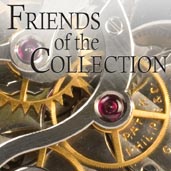Horological Terms
Horology- the art and science of timekeeping
Clock Parts
Short hand- the hour hand on the clockface
Mainspring- the coiled spring that provides the driving force for a mechanical clock or watch
Clockface- the part of a clock where you find the numbers and hands
Pendulum- a free swinging object, such as a weight hanging from a string, which has a back and forth motion
Clock- comes from the French word cloque, which means bell
Escapement- a device that regulates short periods of time so they are always the same length
Foliot- a lever with weighted arms attached to the paddled rod of the verge escapement
Fusee- a spiral pulley used to even out the power of a mainspring in a watch
Anchor escapement- an escapement shaped like an anchor that made pendulum clocks more accurate
Gear- a wheel with teeth on the edge that are made to fit in between the teeth of another gear
Types of Timepieces
Chronometer- a timepiece that is used in navigation to determine longitude
Shadow clock- a clock developed by Ancient Egyptians that uses the sun's shadow to track time
Sundial- tells time by the shadow that the gnomon casts on a calibrated dial
Astrolabe- a device that measures the altitude of the sun or a star to determine latitude
Pendulum clock- a clock that uses a swinging pendulum to move its gears
Atomic clock- a precision clock that is regulated by the natural vibration frequencies of a beam of cesium atoms
Mechanical clock- a clock powered by moving parts
Skeleton clock- a clock that displays its mechanics
Quartz clock or watch- uses a quartz crystal that vibrates at a precise frequency to keep precise time
Telling Time
Second- 1/60 of a minute
Season- a year is made up a four seasons: spring, summer, winter, fall
Week- seven days in a week: Sunday, Monday, Tuesday, Wednesday, Thursday, Friday, Saturday
Year- the time it takes for the earth to travel around the sun; 12 months make up a year, or 365 days
a.m.- abbreviation for the Latin words, ante meridian, meaning before noon.
Clockwise- the hands of a clock always move in the same direction, following the numbers from 1 to 12
Half past- refers to 30 minutes after the hour.
Long hand- the minute hand on a clockface
Digital- show time with numbers instead of hands
Analog- have an hour, a minute, and sometimes a second hand to show the time
Quarter after- refers to 15 minutes after an hour
Quarter to- refers to 15 minutes before the hour is up
Minute- unit of time equal to 1/60 of an hour or 60 seconds
Month- a unit of time corresponding approximately to one cycle of the moon's phases
p.m.- the 12 hours after 12:00 noon. The abbreviation of the Latin post meridiem, meaning after noon.
Date- the day, month, and year when something happens
Day- there are 24 hours in a day. There are 365 days in a year.
Half past- refers to 30 minutes after the hour.
Leap year- a year of 366 days. The extra day, February 29, is added once every four years to make up for the shortage in our calendar.
Light year- the distance that light, which has a velocity of 186,000 miles per second, travels in 1 year
Solar day- how much time passes between noon and noon
Sidereal day- how long it takes the earth to rotate once on its axis
Railway time- a standard time used by railroads that stayed the same, regardless of location
Standard time- the official time in a local region established by law or custom
Zulu time- the mean solar time for the meridian at Greenwich, England, used as a basis for calculating time used by the military and in navigation as a term for Universal Coordinated time or Greenwich time- the local time at the 0 meridian passing through Greenwich, England, which is used as the basis for universal time
Calendar- system of timekeeping that defines the beginning and length and divisions of the year
Almanac- an annual publication showing the positions of the stars and planets on each day and night of the year
Daylight saving time- the adjustment of clocks and watches ahead of standard time, usually one hour, during the spring, summer, and fall months
International Date Line- an imaginary line passing through the Pacific Ocean. Travelers crossing it from east to west add a day to the calendar, and those crossing from west to east subtract a day
Local time- the time at points on the Earth's surface which are on the same meridian or line of longitude
Longitude- the distance along the Equator, measured up to 180 degrees east or west of the prime meridian which is 0 degrees.
Equinox- the day in spring (March 20, 21, or 22) or fall (September 20, 21, or 22) when the number of hours of daylight and nighttime are equal and the sun rises in the east and sets directly in the west
Julian calendar- calendar created by Julius Caesar in 45 B.C.E.
Gregorian calendar- the calendar revised by Pope Gregory the XIII in 1582, which is still used today
Summer Solstice- the date with the longest day and shortest night of the year. In the Northern Hemisphere; June 21 or 22, in the Southern Hemisphere; December 21 or 22
Winter Solstice- the date with the shortest day and the longest night of the year. In the Northern Hemisphere; December 21 or 22, in the Southern Hemisphere; June 21 or 22
Timezone- one of the 24 regions of the globe; loosely divided by longitude, within which the same standard time is used. For each zone west of the Prime Meridian time goes back by one hour and for each zone east it advances by one hour


